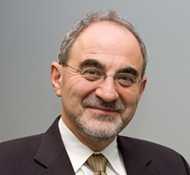Eli Yablonovitch
| Eli Yablonovitch | |
|---|---|
 | |
| Born |
15 December 1946 Puch, Austria |
| Fields | Physics, Electrical Engineering |
| Institutions |
|
| Alma mater | |
| Doctoral advisor | Nicolaas Bloembergen |
| Known for |
|
Eli Yablonovitch (born 15 December 1946) is an American physicist and engineer who, along with Sajeev John founded the field of photonic crystals in 1987. He and his team were the first to create a 3-dimensional structure that exhibited a full photonic bandgap, it is called Yablonovite. In addition to pioneering photonic crystals, he was the first to recognize that a strained quantum-well laser has a significantly reduced threshold current compared to its unstrained counterpart. This technique is now applied to the majority of semiconductor lasers fabricated throughout the world.
He was a professor of electrical engineering at UCLA and continues to study and develop photonic crystals and photonic bandgap materials. As of July 2007, he has joined the Electrical Engineering and Computer Sciences department at UC Berkeley. His other research topics includes silicon photonics, quantum computing, telecommunications, and surface plasmon optics.
He is a Fellow of the IEEE, the OSA, and the APS.
He is also a member of the National Academy of Sciences, the National Academy of Engineering, and the American Academy of Arts and Sciences. In 2013 he was elected a Foreign Member of the Royal Society.[1]
He is a recipient of Adolph Lomb Medal, the Julius Springer Prize, the R. W. Wood Prize, the W. Streifer Scientific Achievement Award, the Mountbatten Medal of the British IET, IEEE Photonics Award, the Harvey Prize and the Rank Prize.
See also
- Alf Adams. Inventor of the 'Strained Quantum Laser Well'.
References
- ↑ "New Fellows 2013". Royal Society. Retrieved 30 July 2013.
External links
- Eli Yablonovitch's Research Group Website at UC Berkeley
- Faculty Web Page at UC Berkeley
- Researcher Bio Page at CITRIS
- Energy Efficiency Electronics Science NSF Center